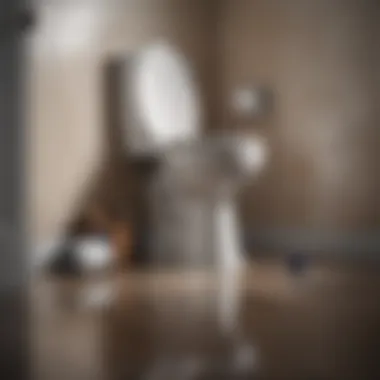Effective Solutions for Clogged Toilets at Home


Intro
Clogged toilets present a common yet frustrating issue in any household. This problem can arise due to a variety of reasons, including excessive toilet paper use, foreign objects, or buildup of waste. Understanding how to resolve this quickly and efficiently can save homeowners both time and money. In this guide, we explore effective methods for dealing with clogged toilets, from traditional tools to innovative techniques that promise results.
Importance of Addressing Clogs Promptly
Not only can a clogged toilet interrupt daily routines, but it can also lead to more serious plumbing issues if left unattended. Water damage, unpleasant odors, and costly repairs may result from prolonged neglect of a simple blockage. Therefore, knowing the best solutions to tackle this issue is crucial.
Tools and Techniques for Unclogging
Several tools can assist homeowners in clearing a clogged toilet effectively. Below are some of the most efficient methods:
Plunger
A plunger is the most basic tool used for unclogging toilets. It functions by creating a vacuum that dislodges the obstruction. Here are steps to use it:
- Ensure a proper fit: Use a flange plunger specifically designed for toilets.
- Position the plunger correctly: Insert it into the toilet bowl, ensuring it covers the hole fully.
- Use forceful thrusts: Push down firmly and pull up to create suction. Repeat as needed.
Toilet Auger
A toilet auger, or plumbing snake, is another effective tool. It is particularly useful for deeper clogs that a plunger cannot reach. The steps for using a toilet auger include:
- Insert the auger: Place the end of the auger into the toilet drain.
- Crank the handle: Turn the handle to extend the snake into the pipe.
- Break up the clog: Once the clog is reached, manually turn the auger to break apart the blockage.
Chemical Drain Cleaners
Although they are not the first recommendation due to potential damage to plumbing, chemical drain cleaners can be useful in certain cases. These products break down waste but should be used cautiously, following manufacturer instructions closely.
It's essential to consider environmental impacts and safety when using chemical cleaners. Non-toxic alternatives are available for those who wish to limit harmful effects.
Preventive Measures
To reduce the frequency of toilet clogs, consider implementing these preventive practices:
- Limit paper usage: Avoid flushing excessive amounts of toilet paper.
- No foreign objects: Remind all household members to keep non-flushable items out of the toilet.
- Regular Maintenance: Use boiling water occasionally to break down buildups within the pipes.
- Professional Inspections: Schedule routine checks with a plumber to identify potential problems before they escalate.
Closure
Understanding how to address and prevent clogged toilets is vital for any homeowner. By utilizing the right tools and techniques, individuals can effectively resolve clogs and maintain their toilet’s functionality. Through careful attention to preventive measures, the likelihood of future clogging can be significantly minimized, ensuring a smoother experience with household plumbing.
Understanding the Clogged Toilet Issue
Understanding why toilets get clogged is essential for anyone managing a household. Clogged toilets are not just a minor inconvenience; they can lead to water damage, expensive repairs, and unpleasant odors. Recognizing the importance of this issue helps in addressing problems before they escalate.
Common Causes of Clogs
A clogged toilet may result from various factors. Here, we explore the common culprits behind this frequent household dilemma.
Excessive Toilet Paper
Excessive use of toilet paper remains one of the leading causes of clogs. People often underestimate how much paper is too much, leading to blockages. Toilet paper, while designed to dissolve in water, can become compacted when used excessively.
This can result in unsightly backups and a need for more drastic interventions. Promoting awareness about the appropriate amount of toilet paper can therefore help mitigate this issue.
Foreign Objects
Foreign objects are another significant contributor to toilet clogs. Items such as children's toys, sanitary products, and wipes can find their way into the toilet. These items do not break down like toilet paper, leading to blockages. Even seemingly harmless objects can cause troubles, making vigilance necessary.
Being careful about what goes into the toilet is thus crucial for maintaining a functional plumbing system.
Low Flush Toilets
Low flush toilets are designed to save water, but they can sometimes lead to more clogs. These toilets use less water, which can result in insufficient flushing power for waste removal. This can be particularly problematic in households with multiple users or where heavy use occurs. Understanding this limitation is vital when choosing a toilet model.
Hard Water Deposits


Hard water deposits can also contribute to clogs. When minerals in hard water accumulate, they can create buildup around pipes and within the toilet mechanism. Over time, this can lead to significant blockages. Regular maintenance and cleaning can help prevent these deposits from affecting toilet function.
Signs of a Clogged Toilet
Being able to identify signs of a clogged toilet early can save time and expense. Certain indicators signal that the toilet is not functioning properly.
Slow Draining
Slow draining is often the first sign that a clog is developing. When a toilet takes longer than normal to empty, it may indicate a blockage forming. Monitoring drainage speed is essential.
If the issue is observed early, appropriate action can be taken before complete failure occurs.
Unpleasant Odors
Unpleasant odors can point to a serious clog or a blockage. If waste is trapped below the water's surface, it can lead to stinky situations. These odors are not just embarrassing; they can also indicate that hygiene is at risk. Recognizing this sign prompts immediate action.
Water Level Fluctuations
Water level fluctuations in the toilet bowl can signify an issue as well. If the water level rises higher or lowers than normal, blockage might be present. This symptom often precedes complete toilet failure. Observing these fluctuations allows homeowners to tackle potential problems earlier.
Traditional Tools for Clogged Toilets
When faced with a clogged toilet, traditional tools play an essential role. Understanding how to effectively utilize such tools can save time and prevent further issues. Each tool has its own strengths and weaknesses, impacting your ability to resolve the problem efficiently. The focus here is on two primary tools: the plunger and the toilet auger.
The Plunger
Types of Plungers
Plungers come in different designs, each suited for various scenarios. The most common types are the cup plunger and the flange plunger. The cup plunger is widely recognized, featuring a rubber cup that creates a seal over the drain. This type is effective for general clogs caused by waste or toilet paper. On the other hand, the flange plunger has an extended rubber flange that enhances its capability to seal the toilet drain. This characteristic makes it preferable for toilet clogs over sink clogs. Choosing the right plunger can significantly increase the likelihood of a successful unclogging effort, emphasizing its role in this article.
How to Use a Plunger Effectively
To use a plunger effectively, one must ensure a firm seal on the toilet bowl's drain. This step is critical as it allows the plunger to generate sufficient pressure to dislodge the clog. Begin by adding water to the bowl if it is low, as this can aid in maintaining the necessary seal. Next, position the plunger correctly and push down with force. A few strong thrusts, followed by pulling up unexpectedly, can create a vacuum effect, often breaking the clog free. Mastering this technique can maximize its effectiveness and reduce frustration during attempts at resolution.
The Toilet Auger
Different Types of Toilet Augers
Toilet augers, also known as plumbing snakes, are specialized tools designed for tougher clogs that are resistant to plunging. They come in various lengths and sizes, with some equipped with a simple crank handle and others featuring more advanced mechanisms. The key advantage of a toilet auger over a plunger lies in its ability to reach deeper clogs, often located further down the toilet line. Users often appreciate this capability for handling stubborn blockages that plungers cannot address, reinforcing its importance within this article.
Step-by-Step Usage Instructions
Using a toilet auger involves several steps. First, insert the auger head into the toilet bowl. Ensure to keep the cable protected from scratching the bowl's surface. Next, rotate the handle to extend the cable into the drain. Continue feeding the auger until you feel resistance. This resistance often indicates that the clog is being engaged. Now, twist and push to break the blockage apart or to reach beyond it. Once the clog is cleared, gently pull the auger back. Remember to clean the tool thoroughly after use to ensure it remains effective for future challenges. Understanding these steps enhances one’s ability to handle a clogged toilet efficiently.
Chemical Solutions for Clogs
The topic of chemical solutions for clogged toilets is vital to understanding how to address this common household problem efficiently. Chemical solutions can offer a quick remedy, especially when traditional tools may not fully resolve the issue. They are designed to dissolve or break down waste and debris, making it easier for the toilet to function normally again. However, the usage of these solutions comes with important considerations. Homeowners should be aware of their impact on plumbing systems and the environment.
Enzymatic Drain Cleaners
What They Are
Enzymatic drain cleaners are biological solutions composed of live bacteria and enzymes. Their primary function is to digest organic matter that builds up in the pipes, such as food remnants, grease, and waste. This characteristic makes them an eco-friendly option, appealing to many homeowners looking for alternatives to harsh chemicals. The effectiveness of these cleaners lies in their ability to break down substances over time, providing a more sustainable method for unclogging toilets.
Advantages and Disadvantages
The key advantage of enzymatic cleaners is their safety. They do not harm pipes or septic systems, which is a significant benefit compared to more aggressive products. However, they often require a longer period to showcase results, sometimes taking several hours to days to clear a clog effectively. This slower action might not suit everyone, especially in urgent situations. Homeowners must consider these factors when choosing enzymatic drain cleaners as their go-to solution for clogs.
Acidic Drain Cleaners
Common Ingredients
Acidic drain cleaners typically contain strong acids such as sulfuric acid or hydrochloric acid. These ingredients are effective in breaking down tough clogs quickly. The strong reactive properties of these acids allow them to dissolve organic matter, fats, and even some types of minerals. The speed at which these products work makes them a popular choice for those requiring immediate results.
Safety Precautions


Using acidic drain cleaners comes with serious safety precautions. The strong chemicals can cause burns to the skin and respiratory issues if inhaled. Therefore, it is crucial to wear protective gloves and goggles while handling these products. Additionally, homeowners should ensure proper ventilation in the area when using these cleaners. Ignoring these safety measures can lead to severe injuries and environmental hazards. As a result, while acidic drain cleaners can be effective, they must be used with a full understanding of the associated risks.
Natural Remedies for Clogged Toilets
The exploration of natural remedies for clogged toilets is essential due to growing environmental concerns and a desire to use safe alternatives to harsh chemicals. Many homeowners are looking for effective yet eco-friendly ways to address common plumbing issues. Natural remedies can be a practical solution that is often easily accessible and budget-friendly. Using ingredients like baking soda, vinegar, and hot water, these methods not only clear clogs but also contribute positively to the maintenance of our plumbing systems.
Baking Soda and Vinegar
Mixing Ratios
The effectiveness of the mixing ratios for baking soda and vinegar is crucial in ensuring that they work properly to unclog toilets. A typical ratio is one cup of baking soda to one cup of vinegar. This combination creates a strong reaction that can break down and dislodge unwanted debris. The popularity of this ratio lies in its simplicity and effectiveness.
Both ingredients are commonly found in households, making this remedy accessible. Moreover, the unique feature of this approach is its dual action: the baking soda neutralizes odors while the vinegar works as a natural disinfectant. However, it's important to note that excessive amounts may create a mess rather than a solution, so adhering to recommended measurements is beneficial.
Application Method
The application method involves careful steps to maximize effectiveness. After pouring the baking soda into the toilet, one should follow with the vinegar and allow it to sit for 30 minutes to an hour before flushing with water. This straightforward method makes it a popular choice among homeowners.
The main advantage of this approach is that it is non-toxic and safe for both the environment and the plumbing, making it an attractive alternative to chemical cleaners. However, it may not always work for severe clogs, and in such cases, additional methods might be necessary.
Hot Water Treatment
Optimal Temperature
When using hot water to clear clogs, understanding the optimal temperature is important. The recommended temperature should be around 140 to 160 degrees Fahrenheit, which is hot enough to help dissolve grease or soap buildup yet not too hot to damage porcelain plumbing.
This method’s key characteristic is its ability to soften solid blockages, especially organic materials. The unique feature is its simplicity and effectiveness, as this remedy requires no special ingredients or tools. One disadvantage is the potential for severe clogs that hot water alone cannot resolve, necessitating additional intervention.
Step-by-Step Process
The step-by-step process for the hot water treatment starts by boiling water on the stove or using hot tap water. Pour the hot water slowly into the toilet bowl from waist height to allow it to gain momentum. This method is beneficial as it requires minimal effort and uses readily available resources.
The primary advantage is that it is a gentle approach to resolving minor clogs without risking damage to the toilet. Alternatively, if the clog persists, it may indicate a more serious issue that requires professional attention. Therefore, while effective, it should be viewed as just one of several possible approaches to toilet maintenance.
Preventive Measures for Toilet Clogs
Preventing toilet clogs is essential for maintaining the plumbing health of a home. By adopting best practices, homeowners can decrease the likelihood of experiencing clogged toilets altogether. Alongside avoiding inconvenient and often unsanitary situations, preventive measures can save money on repairs and professional plumbing services. Understanding these measures allows individuals to utilize their toilets correctly and avoid potential problems.
Appropriate Toilet Paper Usage
Types of Toilet Paper
Choosing the right type of toilet paper can greatly influence the occurrence of clogs. There are generally two main categories of toilet paper:
- Standard Toilet Paper - This traditional option dissolves quickly in water, reducing blockage risks.
- Thick or Premium Toilet Paper - While often softer, this type can lead to problems if used excessively, as it takes longer to disintegrate.
The key characteristics of standard toilet paper make it a popular choice for many households. Its ability to break down in water minimizes the chances of it causing obstructions in pipes. Thick toilet paper, though desirable for comfort, may be better used in moderation.
Usage Guidelines
Aside from selecting the appropriate type, how toilet paper is used also plays a crucial role. Some guidelines to consider are:
- Limit Amount - Use only as much as necessary, typically one or two squares at a time.
- Avoid Flushing Foreign Items - Never flush items such as wipes, feminine products, or paper towels, as these can cause serious clogs.
These usage guidelines highlight that the proper approach can prevent clogs effectively. Gaining an understanding of the volume of paper to use can help maintain fluid drainage in the toilet. Being vigilant about what goes down the toilet is equally important, considering the potential havoc non-flushable items can wreak on plumbing.
Regular Maintenance Tips
Regular maintenance is crucial for ensuring that toilets function optimally. Ignoring this aspect may lead to more significant issues over time. By incorporating a maintenance routine, homeowners can catch minor problems without costly repairs later.
Frequency of Maintenance


Performing regular checks on a toilet should be a routine task. A good practice is to inspect toilets at least once a month for any irregularities, such as unusual noises or leaks. Frequent maintenance can spot signs of wear before they escalate into bigger problems. Scheduling consistent inspections helps to evaluate the system's overall condition.
Checklist of Maintenance Tasks
Having a structured checklist aids in keeping track of maintenance tasks. Here are common tasks to consider:
- Inspect and Clean Toilet Bowls - Regular cleaning prevents the build-up of materials.
- Check Flushing Mechanism - Ensure nothing hinders the flush and water flows correctly.
- Monitor for Leaks - Look for any signs of leaks that may indicate future clogs.
Using a checklist provides a clear structure for maintenance, making it easier to stay organized. The advantages of following such a list include peace of mind and a proper functioning toilet.
By implementing the right strategies, homeowners can maintain proper toilet function and avoid the troublesome experience of clogged plumbing.
When to Seek Professional Help
Understanding when to call a professional plumber can save you time, money, and frustration. In many cases, minor clogs can be handled easily with tools or home remedies. However, there are scenarios where professional intervention becomes necessary. Recognizing these situations not only prevents further damage but also ensures the longevity of your plumbing system. In this section, we will explore how to identify severe clogs and why acting promptly is crucial.
Identifying Severe Clogs
Signs Indicating a Major Issue
Identifying severe clogs is vital for maintaining proper toilet function. Signs indicating a major issue include persistent backups, gurgling sounds, and multiple fixtures draining slowly. If you notice that your toilet is not flushing properly despite attempting basic fixes, this could signal a larger plumbing dilemma.
The key characteristic of these signs is their persistence. If flushing only provides temporary relief or if other drains in the house are affected, it suggests a more serious blockage. This is a beneficial indicator because it prompts homeowners to take action before the problem escalates. Ignoring these signs can easily lead to overflowing toilets and extensive water damage.
Potential Consequences of Delaying Service
Delaying service when faced with significant clogs can lead to dire consequences for your plumbing system. A minor issue, if neglected, can develop into a complete blockage and costly repairs. Water damage from overflowing toilets can damage flooring, walls, and even structural components of your home.
The key characteristic of delaying service is the compounding effect it creates. As clogs worsen, the urgency increases, resulting in higher repair costs. This is a detrimental choice for both the homeowner's wallet and the integrity of the home.
Choosing the Right Plumber
Choosing a competent plumber is essential when professional services are needed. A skilled plumber can discern the specific cause of the clog and rectify the problem effectively. Understanding the qualities to look for ensures you hire someone who is trustworthy and capable.
Qualities to Look For
When selecting a plumber, experience and licensing are primary qualities to consider. An experienced plumber has likely encountered various issues and knows how to handle them efficiently. This enhances the likelihood of resolving your clogged toilet quickly.
The unique feature of this experience is the skillset acquired over time. An experienced plumber can provide insights and preventative tips, adding value to their service.
Questions to Ask Before Hiring
Before hiring a plumber, asking pertinent questions can help assess whether they are the right choice for your needs. Inquiring about their experience, payment options, and whether they provide guarantees on their work are essential questions.
This unique feature of asking questions allows the homeowner to discern the reliability and professionalism of a prospective plumber. It is a wise step that can prevent future hassles and ensure that you are making an informed decision.
Ending
The conclusion of this article serves as a vital summation of the discussions on dealing with clogged toilets. Understanding how to effectively address this common issue is not only beneficial but crucial for maintaining a functional and hygienic household environment. The importance lies in recognizing the wide array of solutions, including traditional tools, chemical options, and natural remedies. Each method has its own strengths and weaknesses, and the appropriate choice often depends on the specific circumstances of the clog.
Summary of Effective Solutions
In this article, we explored various solutions for tackling clogged toilets. A few key options include:
- Plungers and Toilet Augers: Traditional tools like plungers can remedy most minor clogs when effectively used. Toilet augers, on the other hand, can reach deeper blockages that may resist plunging.
- Chemical Solutions: Enzymatic drain cleaners offer a gentler approach, while acidic cleaners can rapidly dissolve stubborn clogs. Each option demands careful usage due to potential hazards.
- Natural Remedies: Baking soda and vinegar provide a non-toxic alternative, while hot water can assist in dissolving minor blockages.
These solutions require the reader to weigh the benefits and drawbacks based on their specific situation.
Importance of Prevention
Prevention is a key theme throughout this article. Avoiding clogged toilets means being proactive about maintenance and usage. Some effective strategies include:
- Choosing the Right Toilet Paper: Using toilet paper designed to disintegrate quickly can significantly reduce clogging risks.
- Establishing a Maintenance Routine: Regular checks can identify potential issues before they escalate into severe clogs.
Ultimately, investing time in these preventive measures can lead to a more functional plumbing system and reduce the frequency of unpleasant surprises. Addressing clogs promptly and understanding preventive strategies creates a smoother experience for homeowners.
"An ounce of prevention is worth a pound of cure."
Emphasizing the interconnectedness of these sections, it is clear that prevention and effective solutions work hand in hand to ensure a well-functioning bathroom. The insights gathered from this guide empower homeowners to face toilet clogs with confidence and informed strategies.







